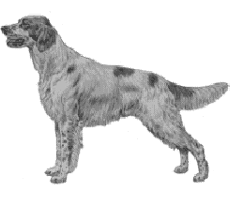Irish Red & White Setter
General Information - Irish Red & White Setter

Group:
Gundog
Size:
large
Lifespan:
12-14 years
Exercise:
very high
Grooming:
medium
Trainability:
medium
Watchdog ability:
high
Protection ability:
very low
Area of Origin:
Ireland
Date of Origin:
1600’s
Other
Names:
none
Original
Function:
bird setting and
retrieving
Irish Red & White Setter
A breed standard is the guideline which describes the ideal characteristics, temperament, and appearance of a breed and ensures that the breed is fit for function with soundness essential. Breeders and judges should at all times be careful to avoid obvious conditions and exaggerations, as well as being mindful of features which could be detrimental in any way to the health, welfare or soundness of this breed.
Breed Standard - Irish Red & White Setter
 General Appearance:
General Appearance: Strong and powerful, without lumber - athletic rather than racy.
Characteristics: Biddable, highly intelligent, good worker.
Temperament: Happy, good natured and affectionate.
Head and Skull: Head broad in proportion to body, with good stop. Skull domed without occiputal protuberance as in Irish Red Setters, fairly square, clean muzzle.
Eyes: Hazel or dark brown, round, slight prominence and without haw.
Ears: Set level with eyes and well back, lying close to head.
Mouth: Jaws strong with a perfect regular scissor bite, ie Upper teeth closely overlapping lower teeth and set square to the jaws.
Neck: Moderately long, very muscular, but not too thick, slightly arched free from throatiness.
Forequarters: Shoulders well laid back. Elbows free, turning neither in nor out. Strong, oval bone well muscled, sinewy, pasterns slightly sloping.
Body: Strong and muscular, deep chest and well sprung ribs. Back and quarters very muscular and powerful. bone strong, well built up with muscle and sinew.
Hindquarters: Wide and powerful. Legs from hip to hock long and muscular from hock to heel short and strong. Stifle well bent, hocks well let down turning neither in nor out.
Feet: Close:knit, well feathered between toes.
Tail: Strong at root, tapering to fine point, with no appearance of ropiness, not reaching below hock. Well feathered, carried level with back or below in lively manner.
Gait/movement: Long free striding, effortless with drive.
Coat: Finely textured with good feathering. Slight wave permissible but never curly.
Colour: Clearly parti:coloured, ie base colour white, solid red patches. Mottling or flecking but not roaning permitted around face and feet and up foreleg to elbow and up hindleg to hock.
Faults: Any departure from the foregoing points should be considered a fault and the seriousness with which the fault should be regarded should be in exact proportion to its degree.
Note: Male animals should have two apparently normal testicles fully descended into the scrotum.
DNZ No 339
Copyright Dogs New Zealand
01 Jan 2002
Any departure from the foregoing points should be considered a fault and the seriousness with which the fault should be regarded should be in exact proportion to its degree and its effect upon the health and welfare of the dog and on the dog’s ability to perform its traditional work.




